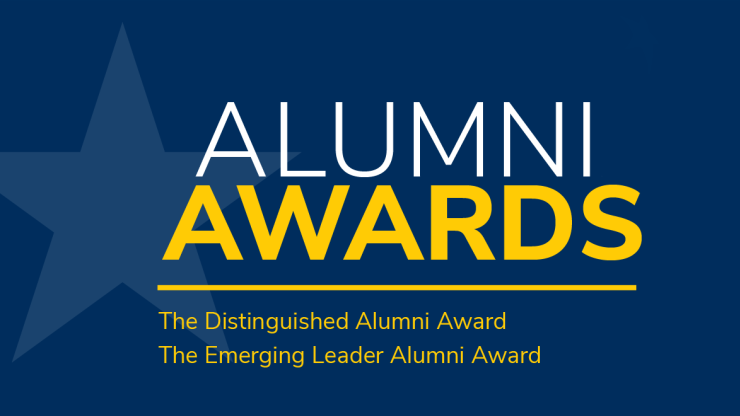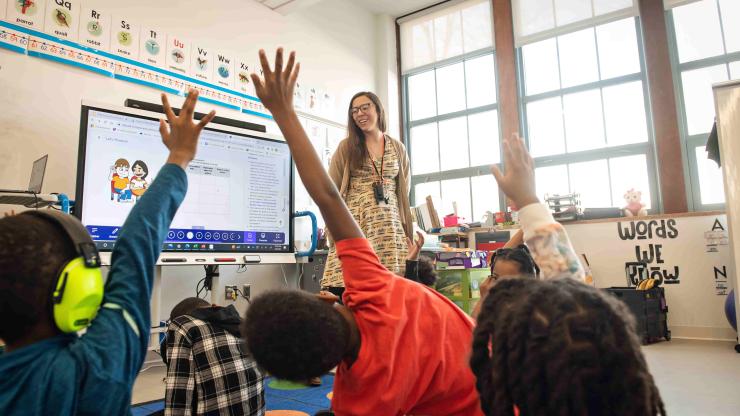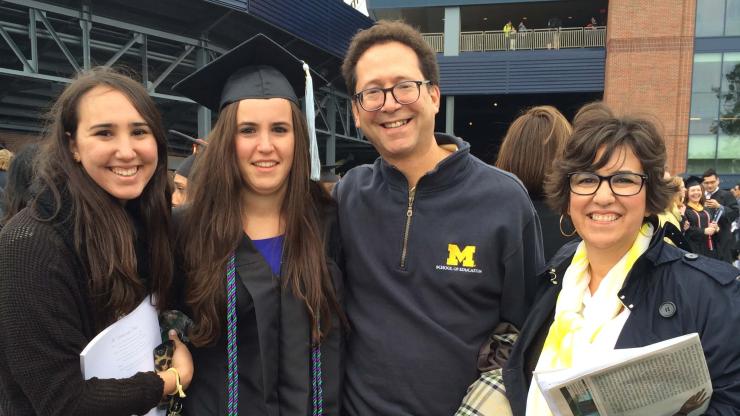Making the First Eight Great
Nell Duke and team design the first comprehensive full-day curriculum for children ages 0-8 with attention to academic and socio-emotional development
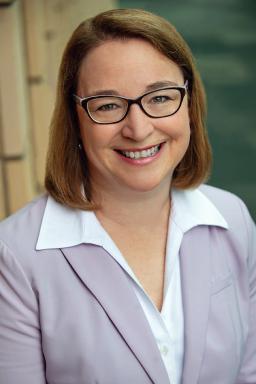
Professor Nell K. Duke is a Marsal School faculty member and Executive Director of the Center for Early Literacy Success at Stand for Children. She serves as a consultant for a number of education and policy organizations, and as one of the world’s foremost experts in early literacy education, speaks widely on that topic. Her work focuses particularly on children living in poverty, examining issues of equity in literacy education, and bridging gaps between research, policy, and practice in early literacy education. In 2018, Duke was awarded the International Literacy Association’s highest honor, the William S. Gray Citation of Merit, for outstanding contributions to literacy research, theory, policy, and practice. She has been named one of the most influential education scholars in the U.S. by EdWeek, and has been involved in a wide range of initiatives designed to reshape literacy education.
Early in her career, Duke interwove teaching with pursuing her academic degrees—and for the past 24 years has served as a professor of education and psychology, first at Michigan State University and then at the University of Michigan.
During her more than two decades in the field, Duke, along with her fellow researchers, regularly witnessed a multitude of issues with existing early childhood curricula. “We had seen so many problems in the curricular landscape,” Duke explains, “such as curricula insufficiently informed by research—or not being updated based on new research.
“We’ve seen teachers who are juggling up to eight different curricula over the course of a day,” Duke continues, “curricula that are often not well coordinated. There’s not enough time to do them all justice, so you end up with key content being neglected. We believed that these and other problems could be addressed by an ambitious and well-designed full-day curriculum.”
It was this impulse that led Duke to undertake the mammoth task of creating a comprehensive, full-day curriculum for children from birth to age eight. Beginning with a planning grant from the George Lucas Educational Foundation in 2016, Duke and collaborators, including Dr. Anne-Lise Halvorsen (AM ’02, PhD ’06)—a University of Michigan alum now at Michigan State University, and Dr. Eve Manz of Boston University, outlined a full-day, project-based curriculum for first grade. “The thinking we did around how to integrate first-grade standards across disciplines helped to inform and accelerate the development of what would eventually become the Great First Eight,” Duke says.
With the groundwork laid and additional philanthropic support from an anonymous donor, Duke teamed up with two of the nation’s leading scholars in social and emotional learning to co-direct Great First Eight (GF8): Dr. Marisha Humphries, a widely published scholar and licensed clinical psychologist who specializes in African American children’s emotional and social competence and the ways schools can support their development in this area, and Dr. Claire Vallotton, whose research, teaching, and service focus on the development and well-being of babies from birth through three years in the context of relationships with their families, educators, and communities. Having a leadership team that focuses on both academic and social and emotional development was intentional and is reflected throughout the curriculum.
In order to develop GF8, Duke, Humphries, and Vallotton assembled a core team of diverse and highly accomplished researchers, practitioners, and advisory board members from around the country, including Halvorsen and Manz, Clinical Professor Debi Khanabis (AB ’98, AM ’99, TeachCert ’99, AM ’06, PhD ’09), and many others. They carefully developed a leadership distribution model that allows for a continuous and seamless transition across the developmental phases as the curriculum for each age group builds upon the last. Within each grade band there are domain-specific leaders who specialize in a particular content area intersecting with a developmental period. The domain-specific leaders oversee the writing of lessons that involve their domain. This model produces developmentally appropriate curricula created by a team of content-expert writers, which has produced a highly efficient curriculum development process. To date, at least 200 individuals have been involved in the GF8 development process.
“There is such great value in developing a curriculum with large and diverse teams of researchers, educators, families, community members, and children,” Duke says. “The curriculum is so much better because of the contributions of people from each of these groups; the whole is indeed greater than the sum of its parts.”
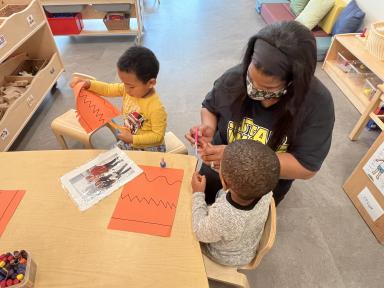
Unlike the vast majority of curricula, which are formulated to be used anywhere with any child, Duke and her team imagined a curriculum designed specifically to build on the enormous potential of children in metropolitan areas—many of whom are affected by structural inequalities. “Because most curricula in the U.S. are intended to be used in classrooms with children of any cultural background, that has meant—in practice—curricula often center whiteness. In contrast,” Duke explains, “Great First Eight is being designed specifically for use in classrooms that serve a number of children from historically underrepresented racial and ethnic groups.”
As one starting point, the Great First Eight team held focus groups with family and community members in communities where they were planning on piloting the program in order to learn what they would like to see in curricula for their children. “We also incorporate input from the children themselves,” Duke says. “For example, we interviewed kindergartners about things they are most interested in and have used some of the topics they suggested.”
GF8’s four advisory boards, as well as other experts who have been recruited to review specific units, have provided input and feedback throughout the curriculum development process. The team also collects and addresses extensive input and feedback from teachers, coaches, and administrators. The feedback from teachers has so far been positive. Seymonnia Cutkelvin, a kindergarten teacher with New York City Schools, noted that “one of the benefits has been seeing kids really grow into an understanding of their own identities and the world and the environment around them,” while her colleague, Cynthia Crespo, enthused that “it got me into my passion again!”
GF8 is being designed to address what Duke and her team have identified as the many limitations of existing curricula, including that:
- Children often experience radically different curricular approaches each academic year. Children’s kindergarten experiences, especially, may bear little resemblance to their pre-K lives, making an important transition more difficult. Because GF8 is continuous from birth through age eight, it creates a seamless experience in which children’s learning builds on itself year after year.
- Schools often use different programs for English Language Arts, mathematics, science, social studies, and social and emotional learning (if they use any programs at all for the latter three domains). This creates a school day that is choppy and disconnected, in which transferring learning from one discipline to another is challenging for teachers and students alike. GF8 is being designed with these learning transfers in mind, and because it is structured to encompass the entire school day, it allows for an integrated experience that is synergistic for children and usable for teachers.
- Science and social studies are often ignored in grades K-2, especially in metropolitan areas that demand progress on high-stakes tests of ELA and math. GF8’s interdisciplinary nature allows for unprecedented attention to science and social studies. By integrating disciplines across the day instead of maintaining siloed “blocks” of time, the GF8 curriculum is able to maximize instructional minutes and ensure children enter third grade meeting not just the Common Core State Standards for ELA and math, but also Next Generation Science Standards; the College, Career, and Civic Life (C3) Framework for Social Studies; and a set of social and emotional learning standards.
- Many of the curricula currently used are insufficiently informed by research—sometimes considering broad findings, but rarely those of individual studies. GF8 is being purposefully designed to reflect findings from a large number of specific, peer-reviewed studies. The eventual goal is to continually update GF8 so this remains true even as scholarship advances our communal knowledge.
- Curricula are often not designed to respond to children from historically underrepresented racial and ethnic groups and other marginalized backgrounds. Although no curriculum can guarantee a culturally relevant and sustaining education, GF8 provides teachers with support to leverage the rich cultural practices of children in metropolitan areas. This support includes quality professional learning, educative features in lesson materials, and thoughtful wording that helps teachers guard against potential inequities.
- Because many curricula don’t do enough to support children’s engagement and agency, GF8 is, first and foremost, respectful of children, ensuring sufficient time for play and nutrition, as well as choices in learning about topics of interest. The project-based nature of GF8 provides authentic, real-world purposes and audiences for children’s work.
In addition to addressing these limitations, GF8 intentionally promotes diversity, inclusion, and equity. Historical figures, characters, authors, illustrators, musicians, members of the local community, and others featured in the curriculum include a high proportion of people from underrepresented and historically disenfranchised social groups. The curriculum promotes children’s pride in themselves and their families and appreciation for diversity within the classroom.
One of GF8’s key principles is that it is designed to be spreadable and implementable at scale. GF8 core materials, including all unit and lesson plans, are being made available free of charge through greatfirsteight.org. XanEdu, Inc., a provider of education content and curriculum services for K-12 and higher education, is pulling together the physical materials—such as materials for science investigations, books specified for read alouds, and math manipulatives—that the schools need to implement Great First Eight, making them available quickly and efficiently to educators.
“Curriculum must be built to scale,” Duke argues, “without losing the ability to respond to specific places, children, cultures, and contexts.” From the beginning, GF8 has been focused on this task. For example, instead of building professional learning that must be provided by the GF8 team, GF8 features online professional learning modules that can be facilitated locally by central office staff or center staff, instructional coaches, or teacher leaders. Each module has a facilitator’s guide to support local personnel in leading the professional learning. The GF8 website not only houses the curriculum and links to professional learning materials, unit and lesson plans for teachers, assessment resources, and child-facing materials (e.g., visual schedule materials), it also includes hip-hop style phonics songs, family engagement materials, and many other curricular resources.
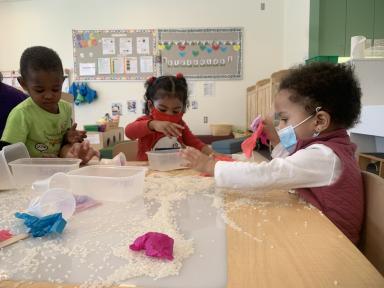
After more than four years of work, the infant, toddler, and kindergarten components of the curriculum are now complete, including high-quality professional learning modules. The piloting process for the infant and toddler components included work with the Marygrove Early Education Center. “We are currently piloting the first grade curriculum in classrooms in Taylor and Ypsilanti, Michigan, and through support from the W. K. Kellogg Foundation, the first grade component will be released in 2023,” Duke says. “With support from Stand for Children, we are in the process of writing the preschool and second grade portions, and next year we expect to be piloting them in classrooms in Michigan and California. Initial development of the entire curriculum will be complete in 2025.”
Increasingly, Duke is focusing on implementing the curriculum at scale. The GF8 team is currently selecting a group of schools nationally to be part of what they are calling the “Vanguard Group of implementers.” These schools will be implementing the kindergarten curriculum in ’23–’24, first grade in ’24–’25, and second grade in ’25–’26.
“We hope to raise funds to recruit infant, toddler, and preschool settings in those same communities to implement Great First Eight, so that there are then children who experience the curriculum from infancy through second grade,” Duke says. “Over time, we plan to expand where Great First Eight is used and continue to update the curriculum based on new research and on feedback from sites that are implementing the curriculum. In 10 years, our goal is for the Great First Eight Curriculum to be in wide use in U.S. metropolitan areas for children birth through age eight.”


